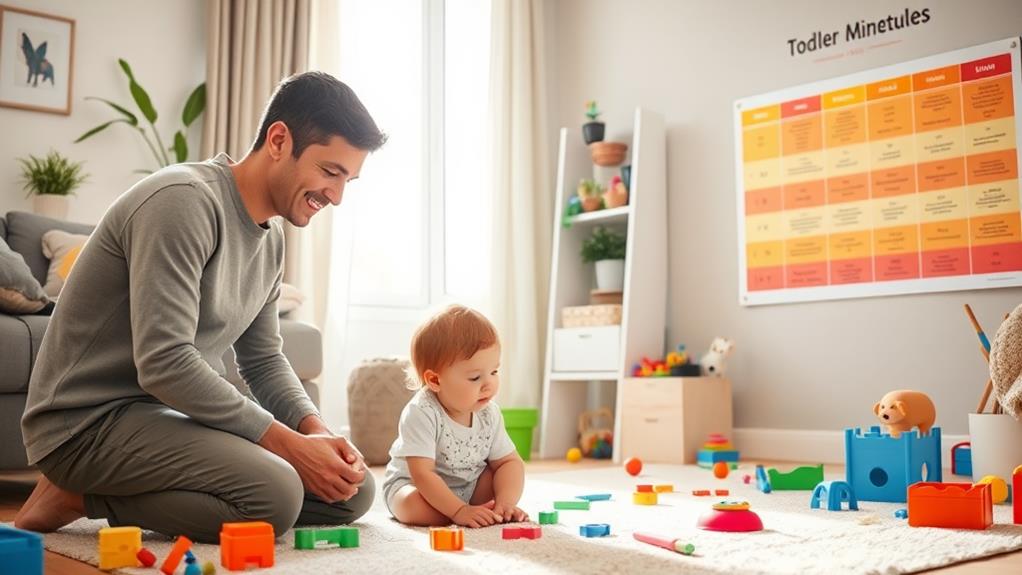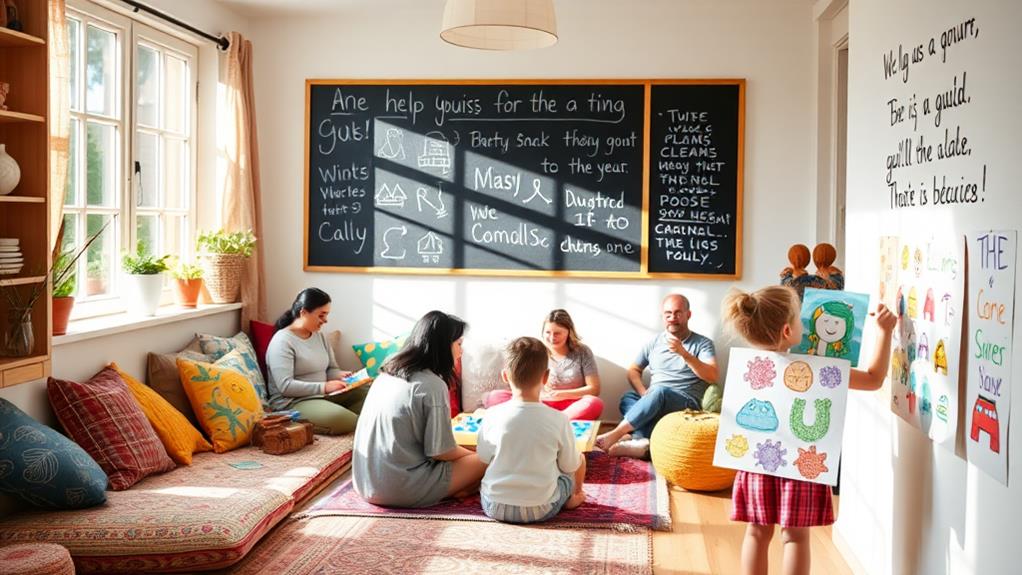When your child exhibits challenging behaviors, it can feel overwhelming, but there are effective strategies you can implement. By staying calm and consistent while understanding the root of each issue, you'll create a more supportive environment. Clear communication and involving your child in decisions can improve cooperation, while routines and emotional expression help establish stability. However, some behaviors may require a deeper examination. Curious about how to effectively address tantrums, refusal to follow directions, or even social withdrawal? Let's explore these common issues and discover practical solutions together.
Tantrums and Meltdowns

When faced with tantrums and meltdowns, it's essential to stay calm and collected. Your reaction sets the tone for the situation. If you panic or react with anger, your child may feel even more overwhelmed.
Instead, take a deep breath and remember that these outbursts are often a child's way of expressing frustration or discomfort.
To tackle tantrums effectively, try to understand the underlying cause. Is your child tired, hungry, or seeking attention? Identifying triggers can help you prevent future meltdowns.
During the tantrum, use a soothing voice to reassure your child that it's okay to feel upset, but they need to express those feelings in a more appropriate way.
Once the storm has passed, talk about what happened. Discuss emotions and encourage your child to share their feelings. This practice not only helps them process their emotions but also teaches them valuable coping skills for the future.
Refusal to Follow Directions
Have you ever felt frustrated when your child simply refuses to follow directions? This common behavior can leave you feeling helpless and confused. Understanding the reasons behind this refusal is key to addressing it effectively. Often, children resist directions as a way to assert their independence or test boundaries.
Start by staying calm and composed. If you react with frustration, your child may dig in their heels even more. Instead, give clear, simple instructions and ensure they're age-appropriate. Use positive language, focusing on what you want them to do rather than what you don't want. For example, instead of saying, "Don't run," try, "Please walk."
Additionally, consider involving your child in the decision-making process. When they feel a sense of ownership, they're more likely to cooperate. You might say, "Would you like to put on your shoes now or in five minutes?"
Lastly, reinforce good behavior with praise when they do follow directions. This helps establish a positive connection between following instructions and receiving recognition.
Aggressive Behavior

Aggressive behavior in children can be alarming and challenging to manage. It often manifests as hitting, screaming, or throwing things, leaving you feeling frustrated and unsure of how to respond.
First, it's essential to understand that aggressive behavior is often a way for kids to express their feelings or frustrations. They mightn't have the words to explain what they're going through, so they act out instead.
To tackle this behavior, start by staying calm. Your reaction can set the tone for the situation. When aggression happens, address it immediately by firmly explaining that hitting or yelling isn't acceptable. Encourage your child to express their feelings through words instead. You can say something like, "I see you're upset. Let's talk about it."
Moreover, observe triggers that lead to aggression. Is your child tired, hungry, or overwhelmed? By identifying these triggers, you can help prevent future outbursts.
Lastly, reinforce positive behavior. Praise your child when they handle frustrations appropriately. With patience and consistent guidance, you'll help them learn healthier ways to express emotions, creating a more peaceful environment for everyone.
Excessive Screen Time
How can you tell if your child is spending too much time in front of a screen? Look for signs like irritability when asked to unplug or a decline in their interest in physical activities. If you notice them skipping meals or chores to binge-watch shows or play games, it's a red flag.
Excessive screen time can disrupt their sleep patterns, leading to fatigue and difficulty concentrating during school or homework.
To tackle this issue, set clear limits on daily screen time. The American Academy of Pediatrics suggests no more than one to two hours of high-quality content for children aged 2 to 5. Encourage alternative activities like reading, outdoor play, or arts and crafts. You might even join them in these activities to make it more fun and engaging!
Create tech-free zones in your home, especially during mealtimes and before bed. This fosters meaningful family interactions and better sleep hygiene.
Lastly, be a role model—if you limit your own screen time, your child is more likely to follow suit. By taking these steps, you'll help your child develop healthier habits and a balanced lifestyle.
Difficulty Sharing With Others

Sharing can be a tough hurdle for many children to jump over, especially when it comes to toys or snacks. Kids often see their belongings as extensions of themselves, making it hard for them to let go.
To help your child develop sharing skills, start by modeling the behavior. Show them how sharing can be fun, like when you split a treat or take turns with a game.
Next, encourage playdates or group activities where sharing is necessary. You'll want to create an environment where sharing feels safe and rewarding. Praise your child when they share, even if it's just a small gesture. Positive reinforcement can go a long way.
Additionally, set clear expectations before playtime. Explain the importance of sharing and how it helps friendships grow. You might even set up a sharing schedule for their favorite toys, which can help them feel more in control.
Lastly, be patient. Learning to share takes time, and every child develops at their own pace. Keep the lines of communication open, and remind them that sharing can lead to more playtime and fun with friends!
Bedtime Resistance
When the clock strikes bedtime, many children suddenly find their energy levels soaring, leading to resistance that can frustrate even the most patient parents. You might notice your child suddenly wanting to play, ask questions, or even negotiate for just a few more minutes of screen time. This behavior is quite common, but it can be managed with a few strategies.
First, establish a consistent bedtime routine. Children thrive on predictability, so creating a calming sequence of activities like reading a story or taking a warm bath can signal that it's time to wind down.
Next, ensure the sleep environment is conducive to rest—dim the lights, lower the noise, and keep the room at a comfortable temperature.
Additionally, try to set clear expectations about bedtime. Let your child know what you expect from them and what the consequences are for not following the routine.
Lastly, be patient and understanding. Sometimes, bedtime resistance is just a way for kids to express their need for attention or connection. By addressing their needs while maintaining consistency, you can help your child embrace bedtime rather than resist it.
Anxiety and Fearfulness

Anxiety and fearfulness can creep in unexpectedly, leaving both children and parents feeling overwhelmed. You might notice your child becoming clingy, refusing to go to school, or showing signs of distress during unfamiliar situations.
It's essential to recognize that these feelings are normal, but they can be tough to navigate.
Start by creating a safe space for your child to express their fears. Encourage open conversations, and let them know it's okay to feel scared sometimes. You can use calming techniques, like deep breathing exercises or visualization, to help them manage their anxiety.
Establishing routines can also provide a sense of stability. Predictable daily schedules can offer comfort, helping your child feel more secure.
If your child is anxious about specific events, role-play those situations to build their confidence.
Frequent Whining or Complaining
Frequent whining or complaining can be frustrating, especially when you're trying to understand what your child truly needs. It's important to remember that your child may not have the words to express their feelings. Often, whining signals discomfort, boredom, or a desire for attention.
Start by observing the context—are they tired, hungry, or overwhelmed? Identifying the root cause helps you respond appropriately.
Try to encourage open communication. Ask your child about their feelings in a calm moment, which can help them articulate their needs better later. You can also set clear expectations by explaining when it's okay to express discomfort and when it mightn't be appropriate.
Offering choices can empower your child and reduce whining. For instance, let them choose between two snacks or activities. This way, they feel in control, decreasing the chances of complaints.
Lastly, reinforce positive behavior. When your child communicates effectively, acknowledge and praise them. This encourages more of that behavior.
Social Withdrawal or Isolation

Social withdrawal or isolation can be concerning for parents, as it often signals that something's not right with your child. You might notice your child spending more time alone, avoiding friends, or showing little interest in activities they once enjoyed.
This behavior can stem from various factors, including anxiety, depression, or even bullying at school.
To tackle this issue, start by connecting with your child. Create a safe space where they feel comfortable sharing their feelings. Ask open-ended questions about their day and listen actively to their concerns.
It's essential to validate their feelings and reassure them that you're there for support.
Encouraging social interactions can also help. Try arranging playdates or group activities that align with their interests. Gradually introducing them to social situations can boost their confidence and reduce feelings of isolation.
If the withdrawal persists or worsens, consider seeking help from a mental health professional. They can provide guidance tailored to your child's specific needs.




































